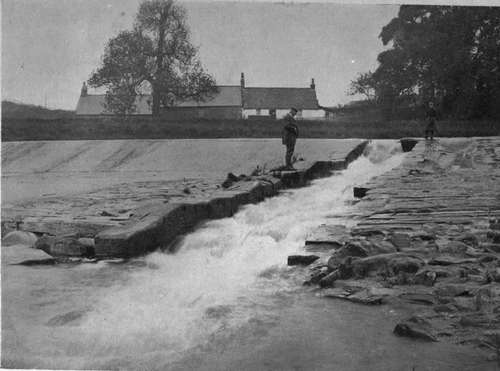Storage And Passes. Part 4
Description
This section is from the book "Salmon Fishing", by W. Earl Hodgson. Also available from Amazon: Salmon Fishing.
Storage And Passes. Part 4
Many thousands of pounds have been spent on the construction of " passes" that were useless. As a rule the problem was looked at by some engineering eye that had little or no regard to what a salmon can or cannot do. In rivers all over the country there are structures which, although Fishery Boards, proprietors, and tacksmen are perfectly satisfied with them, are of no avail to the fish. Some are too complicated; in others the gradient is too steep ; some are lacking in water; others have jumps in them.
This subject being peculiarly susceptible to pictorial illustration, let us contemplate a scene on the North Esk. That shows a bad device. The pass is four feet wide at the top, two feet deep, and about seventeen feet wide at the bottom; the height is about seven feet, and the gradient is 1 in 4 at the top. What is the result ? It is that at times of low water, when fish would have a chance of pushing through the steep gradient at the top, the spread-out water at the bottom is too shallow for them to cross. When the river is high, the fish are unable to stem the current at the top of the fall. A pass of somewhat similar kind is to be seen on the Don at Mugie Moss. It is a channel, cut in the middle of the weir, with a smooth bottom and a steep gradient. The water comes down at such a pace that when they are half-way up the salmon are thrown back. They would have a better chance if the pass were closed and the water allowed to go over the weir, below which, as I write, many hundreds of salmon are probably being taken by the net. This state of things should not be allowed to go on. It robs the proprietors above, and deprives the proprietors below of the increase that would arise if the fish were allowed to go forward. Another dreadful example is the Macdonal fish-way on the Ericht at Blairgowrie. That is an American scheme accomplished at great cost. Not a single fish has ever been known to pass that way. The four passes at the outlet of Loch Vennachar, erected by a well-known engineer forty years ago, were beautiful in design and in workmanship, but they were a failure. The gradient was too steep. Many another pass is merely a slap in the weir, a slap a few inches deep. Now, a weir, as a rule, is from two to three times the average width of the river, and a large quantity of water is taken away in the mill lead. The consequence is that the water in the pass is so thin that salmon cannot get through it at any time of the year when the rain is less than normal, and that when there is plenty of water late in the autumn the fish are too weak, being heavy with spawn, to leap successfully. When the river falls, the arrested fish are easy prey to the poacher.

A Badly Designed Pars Craigo, on the North Esk. - B. D. Malloch.
Continue to:
Tags
salmon, fish, river, fishing, trout, loch, flies, fishing flies
